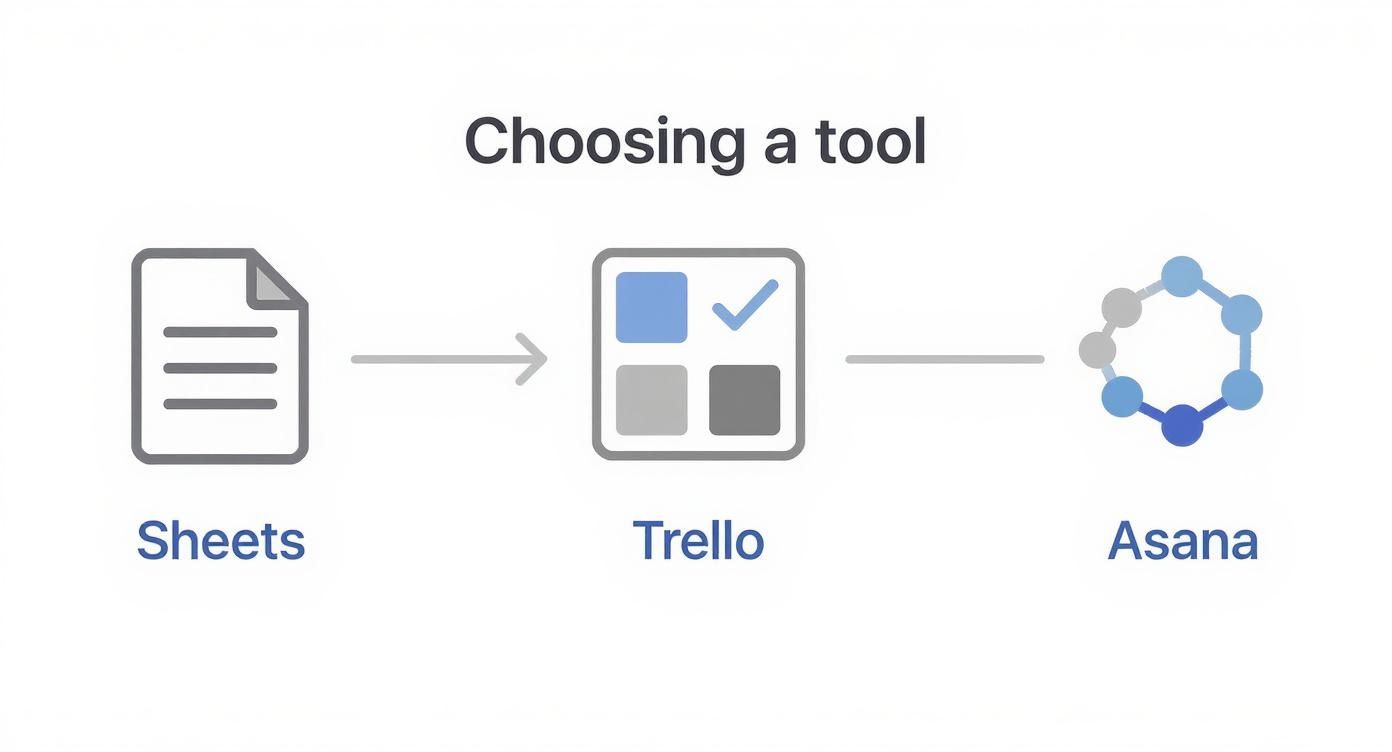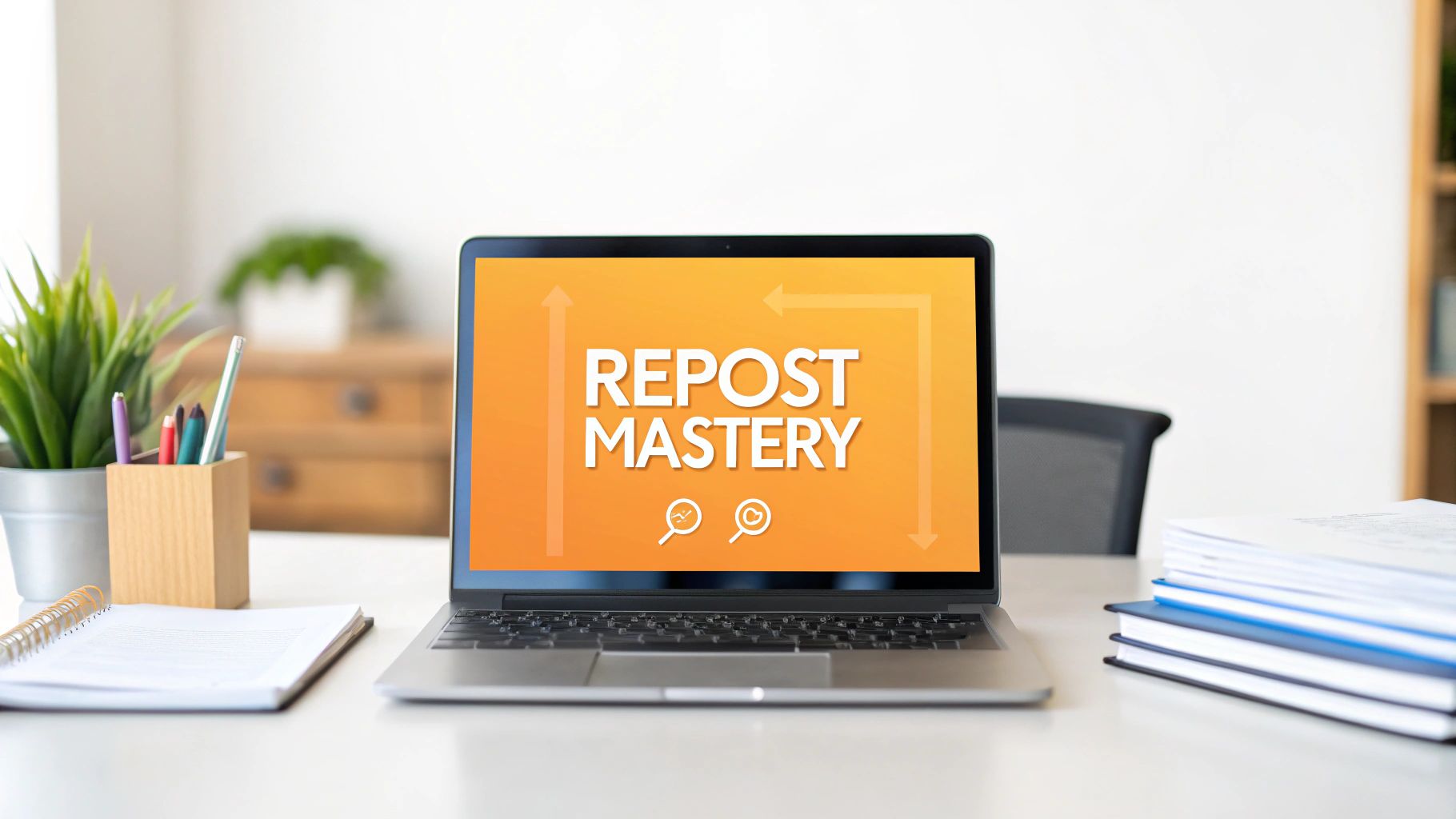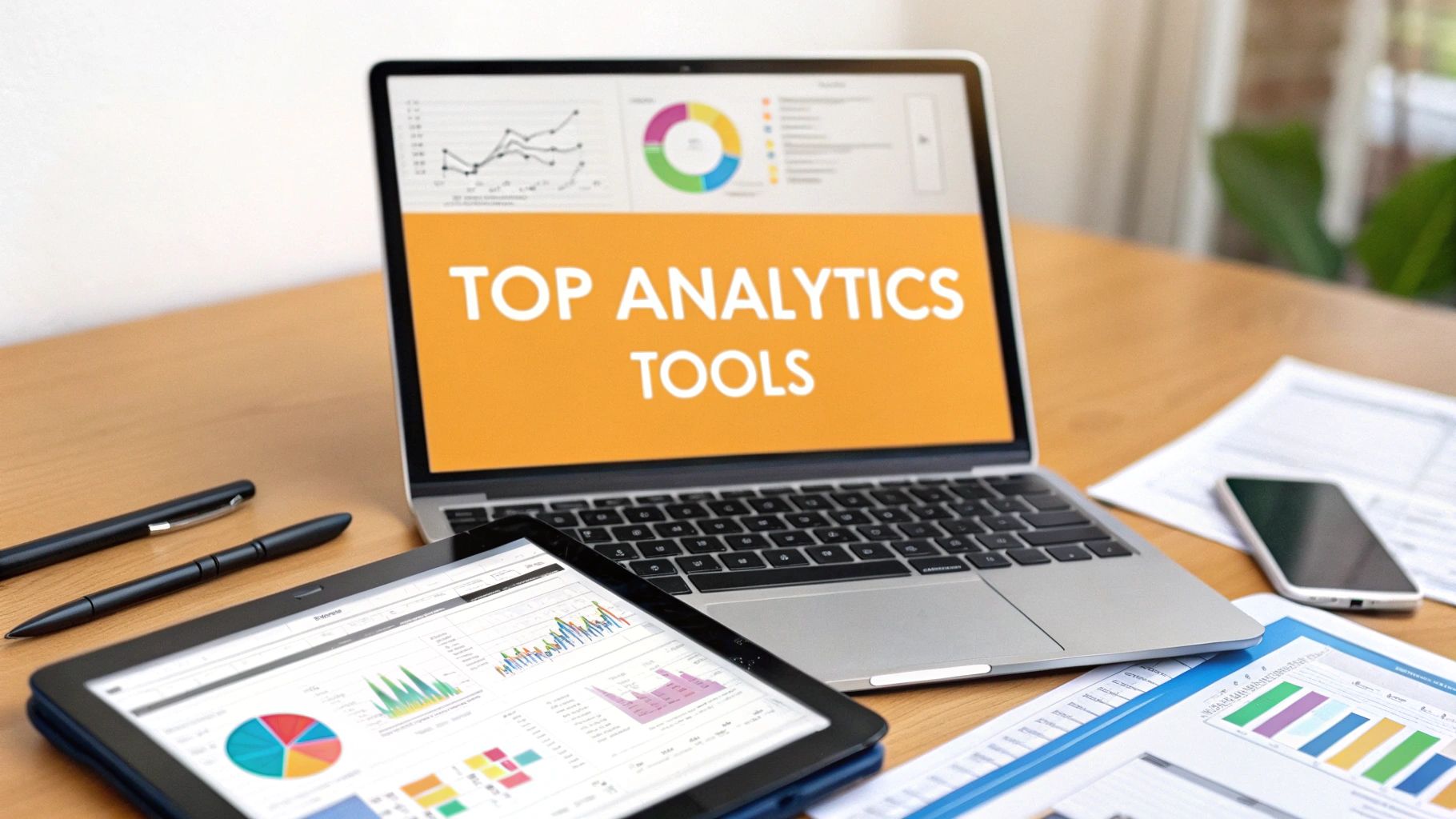So, how do you actually build an editorial calendar? It's less about a complicated formula and more about a simple, repeatable system. You start by nailing down your strategy, pick a tool you'll actually use (whether that's a simple spreadsheet or a project management app like Asana), brainstorm a ton of content ideas that map back to your goals, and then get it all on the schedule.
That's it. This process is what turns the chaos of content creation into a predictable engine for growth.
Why an Editorial Calendar Is Your Secret Weapon
Let's be real. Trying to publish great content consistently without a plan is a total nightmare. It feels like you're constantly putting out fires, scrambling for ideas at the last minute, and watching deadlines fly by. It's almost impossible to connect what you're doing today to your long-term goals.
An editorial calendar is so much more than a document with dates on it. It’s the strategic backbone of your entire content operation, transforming random blog posts and social updates into a cohesive marketing machine.
It’s the difference between just hoping for results and actually engineering them.
From Chaos to Clarity
Think about a team without a calendar. They might drop a fantastic blog post one week, but then radio silence for the next two because another project blew up. It happens.
Now, picture that same team with a solid calendar. They would have planned ahead, maybe even batched all their topic ideas and outlines for the entire month. This kind of foresight kills the last-minute scramble and builds a steady publishing rhythm that your audience can rely on.
An editorial calendar isn't about boxing in your creativity. It's about building a structure so creativity has room to breathe. It gets rid of that "Oh no, what do I post today?" panic and frees you up to focus on doing your best work.
Getting Your Whole Team on the Same Page
When everyone works from a shared calendar, it becomes the single source of truth for your content. It lays out exactly what needs to get done, who’s doing it, and when it's due. This level of transparency is a game-changer for collaboration.
- No More Doubling Up: You can finally stop two writers from accidentally tackling the exact same topic.
- Clear Ownership: Everyone knows their role, whether it's drafting, editing, designing the graphics, or handling promotion.
- Faster Approvals: Managers get a bird's-eye view of the content pipeline, which makes giving feedback and signing off on things so much quicker.
Ultimately, an editorial calendar makes every single piece of content intentional. It ensures every blog post, video, or tweet serves a specific purpose, whether that's to drive traffic, capture leads, or just build up your brand's authority. It's the one tool that powers a truly strategic content program.
Laying Your Strategic Foundation First
Before you even think about opening a spreadsheet or a fancy project management tool, you have to do the strategic legwork. So many people make the mistake of jumping straight into scheduling, and what they end up with is a calendar full of random topics that go nowhere.
First thing's first: what are you actually trying to achieve here? Your content needs to be tied directly to your business goals.
Are you looking to boost organic traffic by 20% this year? Maybe you need more qualified leads coming from the blog. Or perhaps the goal is to become the go-to expert in your niche. Without this clarity, your content is just… content. It’s this foundational thinking that separates a calendar that drives real growth from one that’s just a glorified to-do list.
Define Your Core Content Pillars
With your goals locked in, it’s time to figure out your content pillars. Think of these as the 3-5 big, overarching themes your brand will be known for. They're the main categories that all your content will eventually fall into.
For instance, if you run a fitness app, your pillars might be "Strength Training," "Cardio Workouts," and "Healthy Nutrition."
The sweet spot for your pillars is where three things overlap:
- Your Audience’s Needs: What are their most pressing questions and problems?
- Your Business Goals: How will this content help you hit your targets?
- Your Expertise: Where can you provide genuine, authoritative advice that no one else can?
Getting these pillars right ensures every article, video, or social post you create feels connected and reinforces what your brand is all about. This is a crucial piece of any effective content marketing strategy guide and is what delivers consistent results.
Uncover What Your Audience Is Actually Searching For
Okay, you've got your pillars. Now you can get into the nitty-gritty of finding specific content ideas through keyword research. Don't let this part intimidate you; it doesn't have to be some super-complex process.
Just start by brainstorming the questions your customers ask you all the time. What would they type into Google when they're stuck on a problem your business solves?
You can use a free tool or even just look at the "People also ask" box in Google's search results to get the ball rolling. Try to find phrases that show what the searcher is trying to do. This lets you create content that meets them exactly where they are in their journey.
Don't get caught up chasing keywords with massive search volume. Relevance is what really matters. Answering a very specific question for your perfect customer is way more powerful than writing a generic post that brings in the wrong crowd.
Once this strategic groundwork is solid, you'll be in a great position to, for example, create a church social media content calendar or tackle any other plan to organize your content. Doing the prep work makes filling the calendar a whole lot easier and a heck of a lot more effective.
Choosing the Right Tool for Your Workflow
The best tool isn't always the one with the flashiest features. It's the one your team will actually open and use every single day. I've seen so many teams make the classic mistake of jumping into a complex, expensive platform when a simple spreadsheet would have done the job just fine.
The whole point is to find a system that makes your workflow smoother, not one that adds another complicated step.
Before you even start looking, think about your team. How big are you? How do you actually work together? A solo blogger can get by perfectly with a well-organized Google Sheet. But a small, visual team? They'll probably love the drag-and-drop simplicity of a Kanban board.
Matching the Tool to Your Team
For a lot of people, a basic spreadsheet is the perfect place to start. It’s free, everyone knows how to use it, and you can customize it to your heart's content. You can easily track deadlines, assign writers, and color-code the status of each piece without a steep learning curve.
But once your team starts to grow, you'll feel the limitations. That’s when a more dedicated tool like Trello or Asana becomes a lifesaver. These platforms are built for collaboration, giving you a single place to manage everything from a rough idea to the final published article. They bring much-needed clarity to who’s doing what and when, which is crucial for preventing things from slipping through the cracks.
For example, here’s what a simple Trello board for a content team can look like.
This visual setup makes it incredibly easy to see where every article stands at a glance. Just drag a card from "In Progress" to "Ready for Review," and everyone's in the loop.
Considering Your Content Strategy
The kind of content you're creating should also steer your decision. If you're running a data-heavy SEO strategy, you might find a tool like Airtable more useful. It’s like a spreadsheet on steroids, letting you build powerful databases to track keywords, performance metrics, and content clusters all in one place.
Knowing your audience is just as important. For instance, recent data shows Gen Z spends 54% more time on social platforms than the average person, and 56% of them find social content more relevant than TV. You can find more fascinating stats like this over at wearesocial.com.
If you’re targeting that demographic, your calendar tool absolutely needs to play nice with social media. That means it should integrate well with various channels or at least connect seamlessly with the top social media scheduling apps to make your life easier.
The right tool should feel like an extension of your brain—intuitive, organized, and focused on moving content forward. Don't chase fancy features; prioritize a system that your team embraces and that supports your specific strategic goals.
When in doubt, start simple. You can always upgrade to a more powerful tool as your content machine gets bigger and your needs change. The most important thing is to pick something that makes building and managing your editorial calendar feel effortless, not like a chore.
Bringing Your Editorial Calendar to Life
Alright, this is where the rubber meets the road. All that hard work you put into strategy and brainstorming is about to become a real, working document. Building your calendar isn't just about filling in a spreadsheet; it's about creating the living, breathing roadmap that will guide your entire content operation and keep your team rowing in the same direction.
The very first thing I always do is drop in the content anchors. These are the big, immovable dates that your content schedule will be built around.
Think of them as the main pillars holding up your content house for the year. These typically include:
- Major Holidays: Things like New Year's, Valentine's Day, or Black Friday are easy wins for timely content.
- Industry Events: Got a huge conference coming up? A key trade show? An annual industry report dropping? Get them on the calendar.
- Company Milestones: This could be a big product launch, your company's anniversary, or any other major internal event.
By plugging these in first, you get a bird's-eye view of the year. It makes it so much easier to plan campaigns and themes way ahead of time, so you're never left scrambling for an idea when a big moment hits.
From Pillars to a Pipeline of Ideas
With your anchors in place, it's time to start filling the gaps with a backlog of solid content ideas. Go back to those core content pillars and the keyword research you did earlier—that's your goldmine.
Let’s say you run a small e-commerce shop selling sustainable home goods. One of your content pillars might be "Eco-Friendly Living." Your keyword research probably told you that people are searching for "zero-waste kitchen tips" or "how to reduce plastic use at home."
Boom. Those are your content ideas right there:
- A blog post: "10 Simple Swaps for a Zero-Waste Kitchen."
- A short video: "How to Make Your Own Beeswax Wraps."
- An Instagram Reel: "A Day in the Life of Our Plastic-Free Home."
I've always found that the best content ideas live right at the intersection of what your audience is desperate to know and what your brand knows best. Your calendar is just the tool that turns those brilliant ideas into an actual plan.
Defining the Details That Matter
An idea is great, but it's not a plan. To make your calendar actually work for you, every single entry needs some key details attached. This is what stops things from falling through the cracks.
This is also the point where you need to pick your weapon of choice. Will a simple spreadsheet do the trick, or do you need a more powerful project management tool? Most teams I've worked with follow a natural progression as they scale up.

Whether you're using a Google Sheet or something like Asana, make sure every content idea has these fields filled out:
- Content Format: Is it a blog post, video, podcast, or social media carousel? Be specific.
- Primary Channel: Where's it going live first? The blog? YouTube? LinkedIn?
- Owner: Who is the single person responsible for getting this piece over the finish line?
- Due Date & Publish Date: You need an internal deadline for the final draft and a separate, firm date for when it goes live.
Making sure your team has the right resources is also crucial for getting things done efficiently. For instance, a resource like the 12 Best Content Creation Tools for Social Media can give you some great options for actually producing the content you've planned.
By nailing down these details, you turn a simple topic list into an actionable workflow. That clarity is what transforms your calendar from a wish list into a powerful engine for consistency and accountability, helping you set a publishing pace your team can actually stick to.
Making Your Calendar a Growth Machine

Alright, you've got a working calendar. That’s the engine. Now, let’s add the turbocharger. This is where we stop thinking of the calendar as just an organizational tool and start seeing it for what it is: a strategic asset that can actually multiply your results.
The first big mind-shift is moving away from publishing random, one-off articles. Instead, we need to think in terms of content clusters. You’re not just writing posts; you’re building a web of interconnected content around your most important business pillars.
For instance, say "LinkedIn Content Strategy" is a core pillar for you. Your main "pillar page" would be a huge, comprehensive guide covering everything. From there, you'd plan a whole series of shorter "cluster" posts that all link back to that main guide—things like "5 Ways to Write Engaging Hooks" or "How to Analyze Your LinkedIn Analytics." This strategy tells search engines you're an authority on the topic, which is pure gold for SEO.
Plan to Repurpose Everything from the Start
One of the biggest mistakes I see people make is treating a piece of content as a one-and-done deal. A truly powerful calendar has content repurposing baked into the plan from day one. It’s not an afterthought; it’s a non-negotiable part of the workflow.
Before you even start writing a blog post, your calendar should map out its entire lifecycle.
- The Main Piece: A long-form blog post, like "How to Create an Editorial Calendar."
- Social Fuel: Ten to fifteen bite-sized tips pulled directly from the article for LinkedIn and X (formerly Twitter).
- A Visual Hook: A simple infographic that boils down the main steps.
- Short-Form Video: A quick script for a YouTube Short or Instagram Reel on the "biggest mistakes to avoid."
When you plan this out in advance, you instantly turn a single content effort into a month’s worth of assets for all your channels. It's the best way to get the most bang for your buck without constantly having to create something new from scratch.
Sync Your Content with Your Marketing Campaigns
Your content can’t live on an island. To really see it take off, your editorial calendar needs to be perfectly in sync with your broader marketing campaigns, and yes, even industry ad spend trends.
This is how your calendar starts making you money. Take a look at the global digital ad market for 2025. Projections are hitting over $1 trillion, with digital channels gobbling up around 73% of that spend. Social media advertising alone is on track to be a $242 billion market. We know billions of people are on these platforms daily, so matching your content schedule to where the traffic is makes perfect sense. You can dig into more of these global ad spend statistics on innersparkcreative.com.
Got a big product launch in Q3? Your calendar should be packed with content that supports that launch, warming up your audience for weeks. Of course, this means tracking your results is crucial; understanding how to measure content performance is what helps you connect a specific article directly to campaign success. This kind of strategic alignment is what turns your calendar into a tool that makes every other marketing dollar you spend work harder.
Got Questions About Your Editorial Calendar?
Even with the perfect template and a solid plan, you're bound to run into a few questions once you start putting your editorial calendar into practice. That’s totally normal. Let's walk through some of the most common head-scratchers I see teams run into. Getting these sorted out now will save you a ton of headaches down the line.
The whole point here is to create a living, breathing tool that actually makes your life easier, not just another spreadsheet to keep updated.
How Far Out Should We Actually Plan Our Content?
Ah, the million-dollar question. There’s no single right answer, but I’ve found that planning one to three months ahead is the sweet spot for most people. It gives you enough time to do proper research and create something you're proud of, but you're not so locked in that you can't react to a breaking trend.
If you’re a one-person show, a month might be all you need. It keeps things manageable. But for a larger team juggling multiple campaigns and product launches? You’ll probably want that full three-month (or quarterly) view to keep everyone on the same page.
A pro tip? Sketch out the big-picture themes for the quarter, but only fill in the nitty-gritty details for the upcoming month. This gives you both a roadmap and the flexibility to take detours.
Isn't This Just a "Content Calendar"?
You’ll hear people use “editorial calendar” and “content calendar” interchangeably, and honestly, it's usually fine. But if you want to get technical, there's a subtle difference that can be pretty useful.
- An editorial calendar is your high-level strategy. Think of it as the bird's-eye view—it maps out the major blog posts, videos, and pillar content you're creating.
- A content calendar gets down into the weeds. It’s where you’d schedule the specific tweets, LinkedIn updates, and email newsletters that promote those bigger pieces.
I like to think of the editorial calendar as the "what and when" for your big ideas, while the content calendar handles the "how and where" of getting the word out. Most teams just roll them into one master calendar to keep things simple.
How Do I Get My Team to Actually Use This Thing?
This is the big one. Because a calendar nobody looks at is just digital clutter. The secret to getting your team on board is to make the calendar the single source of truth for everything related to content. No exceptions.
It needs to be part of your team's daily life. Weave it into your weekly meetings, even if it's just for a quick five-minute review of what’s coming up. Make sure every single task has a name next to it—accountability is built right in that way.
But the most important thing? Build it with them. When your team helps create the plan, they're way more invested in making it work. And for goodness sake, keep the tool simple. If it’s a pain to update, people will find every excuse not to touch it.
Ready to stop staring at a blank page and start creating high-impact LinkedIn content in minutes? RedactAI is the AI-powered partner that helps you generate, schedule, and analyze your posts while preserving your authentic voice. Join over 21,000 creators and start for free at RedactAI.






























































































